(Continued from the last page.)
There are many ways to visit Alaska from the Lower 48 states. Each has its
advantages and disadvantages, some of which I'll mention here.
1. BY ROAD TRIP IN YOUR OWN VEHICLE
If you have lots of time and own a comfortable, reliable passenger
vehicle or RV, I recommend a road trip in your own vehicle through
Canada to Alaska. This gives you the maximum flexibility to go where you
want, when you want.
The obvious downsides are the time it takes and the additional
mileage on
your personal vehicle(s).
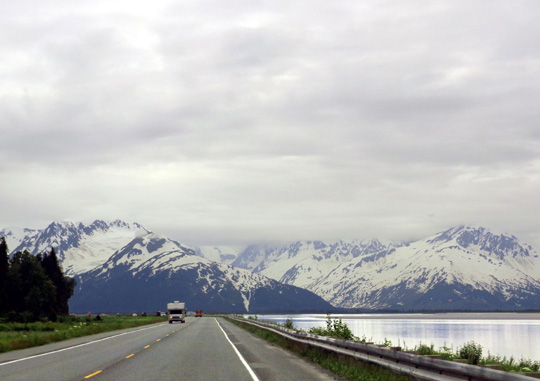
"Cruising" the Seward Highway in an RV around Turnagain Arm
south of Anchorage (7-2-12)
You can also rent an RV or passenger vehicle. I don't know how that cost would
compare to using your own vehicle or flying to Alaska and then renting a
vehicle, but it would give you the advantages (and still some disadvantages) of a
long road trip through Canada.
We also saw folks traveling the length of the Alaska Hwy. and all
around Alaska on motorcycles and touring-style bicycles. Some stayed in tents in
campgrounds, some in
motels or other accommodations along the way.
There are several highway routes from Washington, Idaho, and Montana
to get to Alaska and back. Most are paved roads. Some are dirt/gravel
roads. You can go out and back the same way or vary
the route on the return for more variety. There are also many
opportunities to take side trips along the way.
The
North to Alaska website has general maps and
descriptions of these routes. You can see them in greater
detail online than on the map below:
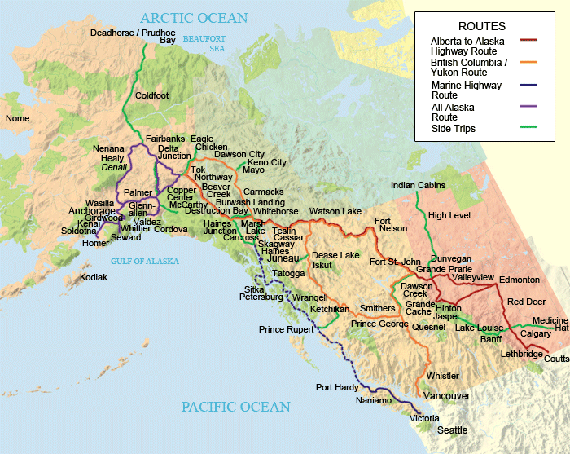
We went up on the traditional eastern route from Great
Falls, Montana through the Coutts border station to Calgary
and Edmonton, Alberta, then the Alaska Highway from Dawson Creek,
British Columbia through the southwestern part of the Yukon Territory to Alaska.
This route is shown in red on the map above.
Our goal was to get to Alaska in a timely
manner -- without too many miles a day -- so we could
spend the maximum amount of time in Alaska. We figured we could spend more time on
the way back or visit places that interested us in Canada on another
summer trip.
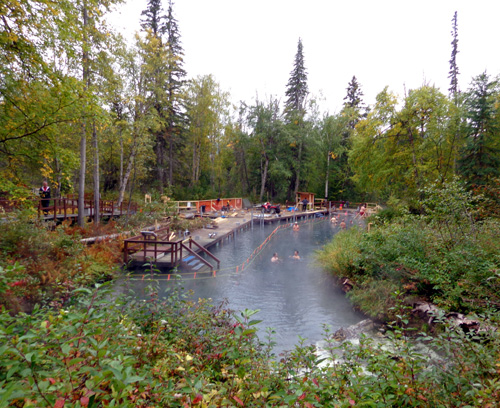
The Liard River Hot Springs is a
favorite destination for travelers on the Alaska Hwy. through
NE British Columbia. We by-passed
it in June on a rainy day. When we stopped to look at it in
September people were using the pools but the
decking was being LOUDLY remodeled. (9-9-12)
Weather often dictated how many miles we drove each day, where we
stayed overnight, and what we did while in transit to Alaska.
We would have spent more time in Whitehorse, e.g., if we hadn't
gotten stuck in Watson Lake for five days due to washouts from heavy
rain and snowmelt in the Yukon in early June. By the time we finally got
to Whitehorse we were "driven" to reach Alaska as soon as possible and
didn't even stay overnight.
Then a combination of lousy weather and tourism fatigue altered our plan
for a leisurely trip back through Canada on the Cassiar and Yellowhead
Highways in September, capped off with a visit to Banff and Jasper
National Parks along the Icefield Parkway in southwestern Alberta.
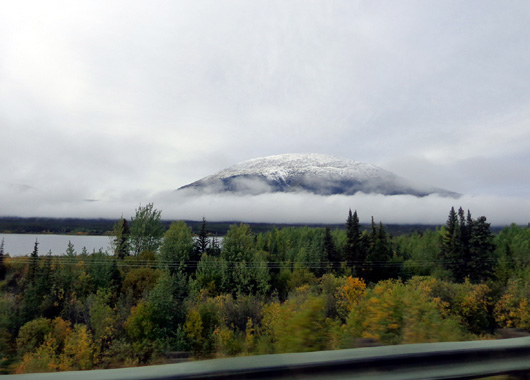
"Terminal dust" (early snowfall
in autumn) and low clouds
over a lake in the Cassiar Mtns.
in the Yukon (9-8-12)
We just had bad timing. Predictions were for sub-freezing
temperatures, snow and ice, and high winds on the days we'd be in that
area. The weather was great shortly before and after that but we didn't
want to wait for the weather to improve.
We chose to stay farther north and east on the Alaska Hwy. through
British Columbia and Alberta on the return trip. We had more sun and
warmer temperatures on that route.
I was a little disappointed we wouldn't be seeing some new scenery
on the return trip but most things did look different going "backwards" on the same route
we took to get to Alaska. In fact, we didn't even recognize some of the
mountainous terrain we'd driven through three months earlier because of
rain or low clouds in June.
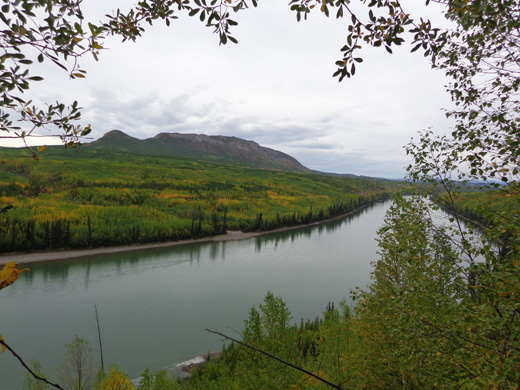
Allen's Overlook above the Liard
River in British Columbia; legend has it that pirates
used this vantage point to prey
on boats carrying goods up and down the river. (9-9-12)
Our timing through Alberta was good in another way, too -- we missed
very high winds and a wildfire next to the highway
south of Calgary by just one day.
Whew! You just never know what kind of hazards you'll encounter in
the Far North!
While we were camping at Malmstrom AFB in Great Falls, MT in
mid-September two
couples who drove their RV to Alaska told us they started down the Cassiar
Highway a few days earlier but turned around after 30 miles because the
road was narrow and rough. They returned via the Alaska Hwy. That
made us feel better about our decision to use that route on our way
back to the Lower 48.
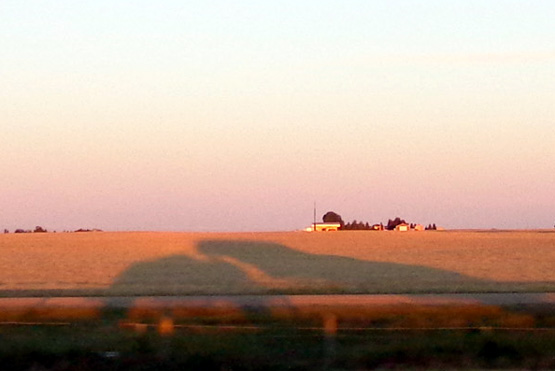
Distorted early morning shadow of
our truck and camper as we traveled through
southern Alberta prairie lands on
our way back to the Lower 48 (9-12-12)
Before our trip we had read many accounts of adventures and misadventures on the
Alaska Highway. We tried to mentally, if not physically, prepare
ourselves for the worst.
Our experience was that the road surfaces weren't as bad
as we expected going outbound . . . but we were surprised they
weren't significantly improved on the way back.
I guess we expected too much. We assumed the roads would be in better shape after all the work
done on them
during the summer to repair frost heaves, permafrost waves, cracks, and potholes from the
long winter. Although most of the gravel breaks, potholes, and wavy
areas were re-paved by fall, I
swear some places were worse than they were in June. That's
probably because we were more tired on the way back.
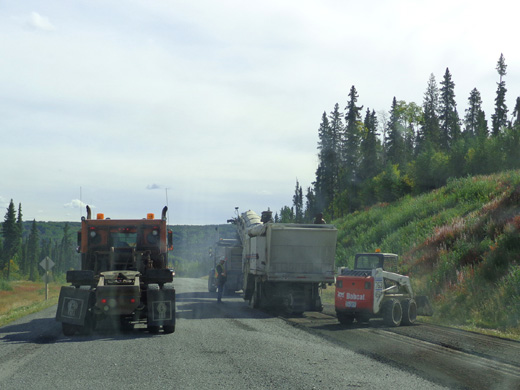
Road work in NE British Columbia
somewhere south of Fort Nelson;
they better get busy because winter is just around
the corner. (9-10-12)
I can see why that might be true up in the Yukon, where road crews were
still busy repairing the washout and mudslide damage that occurred
throughout the province around June 7. There were still several places
on the Yukon-511 website in early September where symbols showed work
being done.
For example, the dirt "pioneer
road" we crossed over Canyon Creek west of Watson Lake on June 12 --
the spot that caused the unprecedented five-day closure of the Alaska
Highway -- was still in use when we returned over it three months
later:
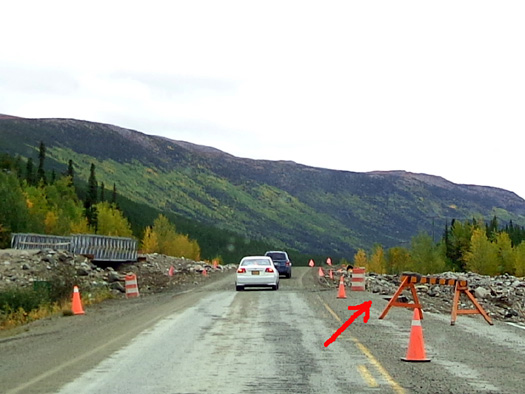
There is still one-lane traffic
over Canyon Creek; the arrow points to the large
section of the highway that was
washed out in June -- it hasn't been filled in yet. (9-8-12)
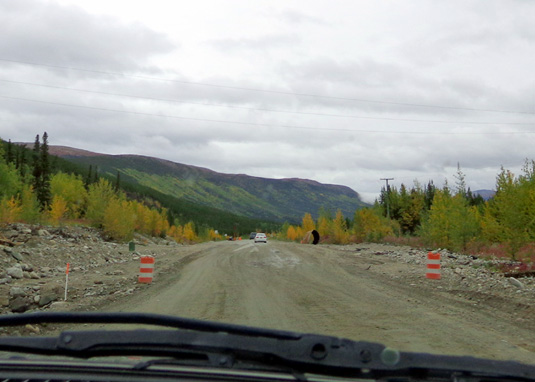
The roadway beyond is still the
"pioneer" dirt section we crossed in mid-June. (9-8-12)
Apparently the highway department didn't have the time or $$$ to
bother with all the frost heaves and holes.
Another couple we talked with at Malmstrom
AFB in mid-September used to live in Alaska. They said they have made the trip up
or back from the Lower 48 at least thirty-five times. They heard the
repair at Canyon Creek hasn't been done because the U.S. promised to pay
Canada $34 million to do the work -- but won't pay it until the
job is completed. Supposedly Canada wants the money up front to pay for labor
and material costs.
Now it's a reported stalemate and little has been done to fix the
road.
I know the U.S. pays Canada part of the cost of repairs on that
highway because it's the only practical truck route for commerce to flow
in and out of Alaska. I don't know if this is the whole story about this
particular repair. Other communities in the Yukon, like the capital city of
Whitehorse, are also dependent on that road, so it behooves the Canadian
government to do its part, too.
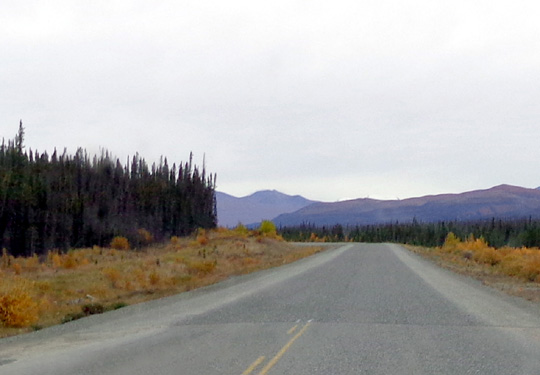
New pavement on the Alaska Hwy.
in the Yukon that hasn't been painted yet; we ran into many
unpainted sections like that in
northern Canada in both June and September. (9-7-12)
I don't know the condition of the other routes to Alaska. I do know
all are subject to the same long winter conditions and permafrost and
that all or most of them suffered damage from too much rain and runoff in
June. Road crews in the Far North stay busy all summer but they can't
keep up with all the damage.
2. BY ROAD TRIP ON A TOUR BUS
Some people travel to Alaska on tour buses. They are subject to the
same road conditions and possible closures as folks who travel in their
own vehicle.
We saw several tour buses in Watson Lake, YT when we were stranded
there for five days in early June. There weren't enough places in that
small town for that many passengers to bed down for several nights (even
in the homes of local residents) so
most companies had to alter their itinerary in some way.
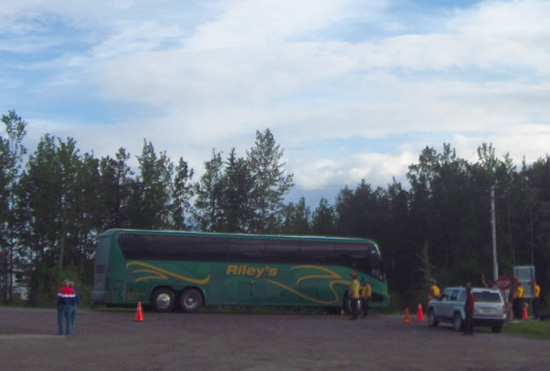
One of the tour buses stranded in
Watson Lake leaves to a cheering crowd the night the road reopened.
Commercial trucks, buses, and
folks in dire need to move up the road were the first to leave town.
(6-11-12)
There was no other way for them to get to Alaska by road. The only
alternate road is unpaved, twice as long, and had even worse mudslides
and washouts than the Alaska Highway.
I see a lot more disadvantages to this mode of travel to Alaska than
advantages. Maybe that's because I've never been interested in taking a
long bus trip. Maybe I'll think differently when I'm less independent.
The only advantages I can think of are leaving the driving
to someone else and avoiding wear and tear on your own vehicle.
Otherwise, you're pretty much at the mercy of the tour company's
itinerary and decisions.
3. BY AIR
Flying into Anchorage or Fairbanks is a popular and practical way to
reach Alaska for folks who have only one, two, or three weeks for a
vacation. Then they can rent an RV or passenger vehicle to explore the
areas they wish. They still have flexibility to go where and when they
want and they aren't adding wear and tear to their own vehicles.
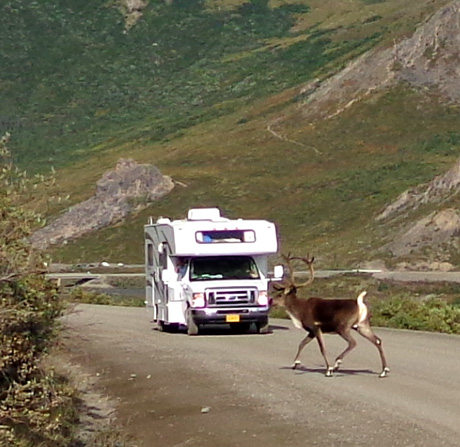
A rental RV at Denali NP waits as
a male caribou crosses the park road just past
Savage River. These folks
were on their way to the Teklanika Campground. (8-15-12)
We were especially cognizant of rental RVs at Denali National Park.
It seemed like more than half of the people camping there were in small Winnebago-type Class
C motorhomes like the one above from two or three rental companies that
apparently do a booming business in Alaska. None stayed at the
campgrounds very long, although it was hard to tell since they all pretty
much looked alike (the RVs, not the people!).
In contrast, there were more state residents in their own campers
(usually pop-ups, small travel trailers, or truck campers) at popular
public fishing venues on the Kenai Peninsula when the salmon were
running, and a majority of retirees in their own
larger 5th-wheels and motorhomes at the military and private campgrounds
where we stayed.
Jim and I like to camp in a wide variety of places. I'll cover
our camping experiences in Alaska and northern Canada on another page.
4.
BY WATER
Many folks travel the Inside Passage on cruise ships they board
farther south along the West Coast (e.g., Vancouver, BC), then either return on the same or a
different water route or get off the ship for various land packages to
briefly explore South Central and/or Interior Alaska. They usually have
short stops at cities and towns along the southern Alaska coast, too,
such as Juneau, Haines, Skagway, Ketchikan, or Petersburg.
Farther north and west, large ships can dock at Valdez, Seward, Homer, Anchorage,
and perhaps some other ports with deep water. We saw this huge cruise ship in the harbor at Seward:
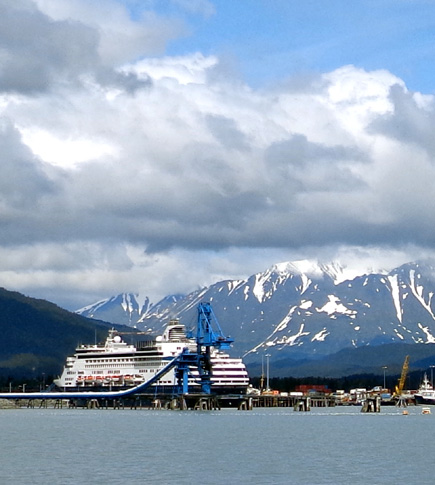
Cruise ship in Seward harbor (7-6-11)
If they choose to explore more of Alaska, passengers have another
choice to make (before booking their tour) -- strike out on their
own in a rental RV or passenger vehicle or choose various air and land
packages offered by the cruise line.
Princess, Holland, and other companies transport their customers via bus, train, or
plane to other popular tourist destinations around Alaska like Seward,
Homer, Valdez, Whittier, and Denali National Park. We saw numerous tour
buses on the George
Parks Hwy. between Anchorage and Fairbanks; Denali National Park is located on that
highway. The companies have their own resort hotels in some of these
places.
Customers have some choices re:
where they go and for how long but once booked, they're pretty much locked in to that
itinerary. This is one way to go if you want to leave all or
most of those decisions to someone else.
5. VARIOUS COMBINATIONS OF THE ABOVE
There are unlimited combinations of air, rail, water, and land travel
to and around Alaska. We discovered some of them in conversations with
other visitors we met. Either the tour companies plan everything or
travelers come up with their own combinations. The latter requires a lot of
coordination but offers the variety preferred by many people.
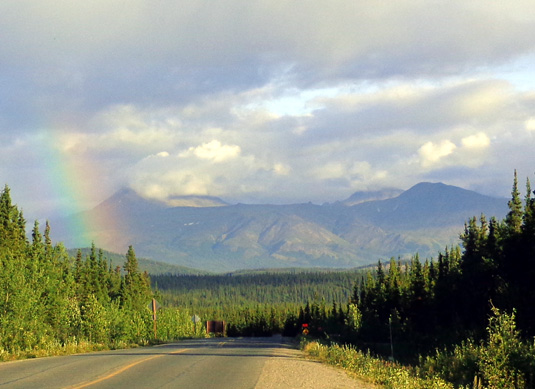
Rainbow we saw from Denali
National Park (8-5-12)
The itineraries can be pretty stressful, though -- too many
places to see in too little time to enjoy any of them. Here's an example
and an obvious warning:
A TRAVEL ITINERARY FROM HELL
When planning a trip to Alaska, whether it's by road, air, or water,
beware trying to do and see so much in so short of a time that
everything is a blur afterwards. You're supposed to relax on a
vacation, not go back home totally exhausted.
I met a 50-something couple on one of my shuttle bus rides in Denali
National Park the second time we camped in the park (late August/early
Sept.). They had just ten days, including travel to and from Texas,
to spend on their first vacation in Alaska and they wanted to
maximize the experience they had. They made all their arrangements
through one of the larger tour companies.
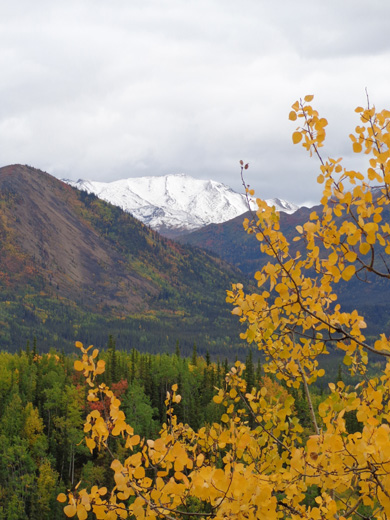
Fall color (golden aspen leaves)
and fresh snow in Denali NP on August 28
Tuesday morning they got up at 3 AM to catch their first flight from
southern Texas. They reached Fairbanks late that afternoon (a long trip, even
after gaining two hours in the process between Central and Alaska Time). When they
arrived something was wrong with their hotel reservation for that night
and the tour company was unable to make alternate arrangements that
suited them.
They decided to rent a car on their own and drive 125 miles to Denali
NP during the night. That takes more than two hours on the
sometimes-rough George Parks Hwy., especially if you've never driven it before.
On Wednesday morning they caught an early shuttle
bus in the park to Eielson Visitor Center (66 miles into the park, then
back out to the entrance = an 8-hour trip if all goes well).
All did not go well that day.
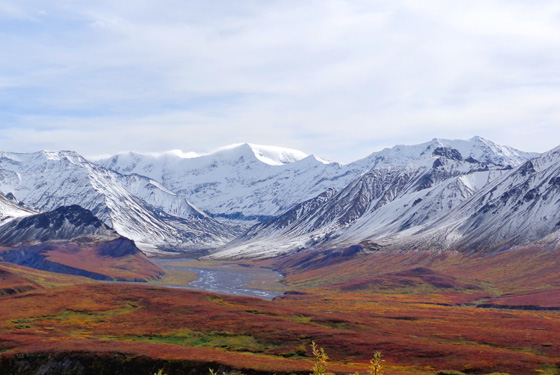
More fall color at a higher
elevation in Denali NP -- snow blankets Mt. Eielson
and red leaves on low shrubs
cover the taiga (sub-alpine terrain). (8-29-12)
While they were at Eielson on Wednesday afternoon there was a
complete lock-down for about three hours while a large male grizzly bear
roamed the area. They didn't even get to see that bear.
That's the day I learned just how much bears rule at Denali and
people have to adapt.
Folks like this couple who arrived in shuttle buses shortly before
the lock-down had to wait to re-board their buses until the bear
wandered far enough away for rangers to deem it safe for people to be
outside the visitor center again.
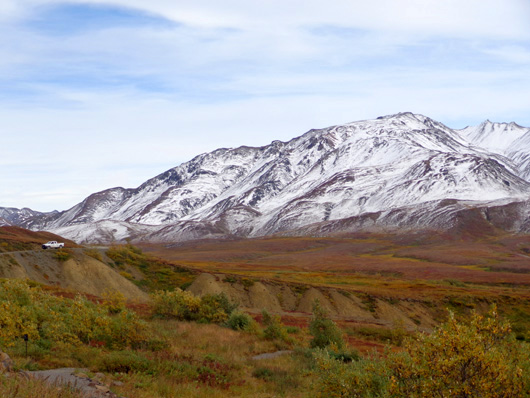
My view from the Eielson Visitor Center before
visitors were herded inside. A ranger in the white
truck kept an eye on the grizzly bear down in
the gully. When it emerged, we were all placed
on "lockdown" inside the building until it wandered
far enough away. (8-29-12)
At the beginning of the lock-down I was high up an alpine trail above
the visitor center and had no clue what was going on. When I got back
down about 2:30 PM I found the sign below at the trailhead and had to
wait a couple hours to catch a park shuttle bus back to the entrance.
I ended up on this couple's bus because it had some empty seats.
By now they had had no sleep since 3 AM the previous morning (i.e.,
about 36 hours). They weren't having much fun in Alaska so far!
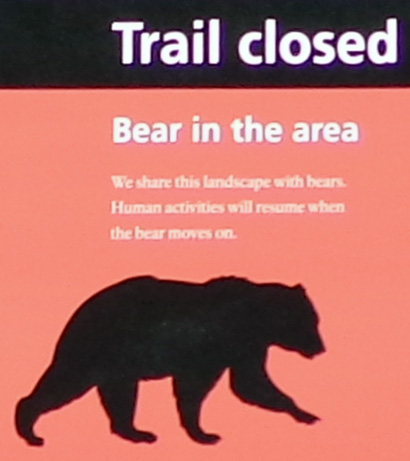
Sign posted at the Eielson Visitor Center the day
it was shut down temporarily. (8-29-12)
Our bus didn't get back to the park entrance until almost 8 PM. This
couple had to drive more than two hours back up to Fairbanks to return
their rental car, get some sleep, and then turn around the next morning and ride the tour
company's bus back down to Denali. Their itinerary called for a few
hours to spend in the park on Thursday afternoon and Friday morning,
overnight Thursday in the company's resort hotel outside the park
entrance, then a three-hour ride down to Anchorage.
The remainder of this couple's itinerary was a whirlwind of stops
around Anchorage and the Kenai Peninsula via bus and train, with no more than part of
a day in each area.
Then they were going to catch a cruise ship down the Inner Passage to
Vancouver, making a few brief stops along the way. They were to fly from
Vancouver back to southern Texas on the 10th day, when they'd "lose" the
two hours they "gained" going to Alaska.
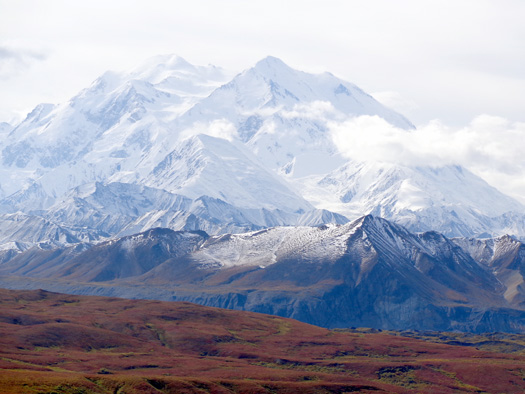
At least they had the pleasure of
seeing Denali that day on the bus. (8-29-12)
It wore me out just to listen to their schedule!
When I met them they'd been
in Alaska fewer than two days and were already exhausted and discouraged.
The only things that brightened their day on the shuttle bus were seeing
Denali Peak (above) and getting to watch a
grizzly bear right below their window . . .
. . . on a shuttle bus tour
not included in their package . . . that they arranged on their
own . . . when they had no room at the inn! How ironic.
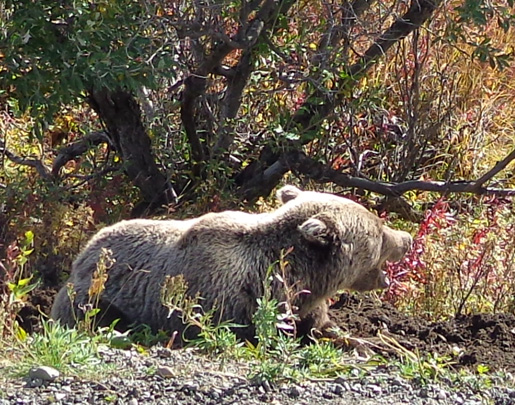
This is the large male grizzly bear they
got to see. It was digging
for roots in the dirt at the edge of the
road. (8-29-12)
Can you tell I'm too independent to do any type of tour like this??
Alaska is a huge state, especially if you include places off the
highway grid. Its land mass is larger than Montana, California, and
Texas combined, one-fifth the size of all the other 49 states.
We spent nearly three months in Alaska and didn't begin to cover
all the places we could have gone. It's impossible to do everything
you'd like to do in just a few days or weeks, even if
you really are only 35 (Jim and I still joke about "not being 35
any more"). If you go to Alaska, do yourself a favor and don't try
to see and do too much in too little time. I think it would be a lot
more fun to pick a smaller area in the state and really get to know it,
then visit another area the next time (because you'll probably want to
go back!).
This Texas couple's schedule reminded me of the romantic comedy,
"If It's Tuesday, This Must be Belgium," a late-1960s
movie about a nine-country,
eighteen-day whirlwind bus tour in Europe -- only this couple's
experience wasn't turning out to be very romantic or comical.
I hope the rest of their trip turned out better than the first two
days.
IT'S SO FAR AWAY -- WHY DRIVE THERE?
Getting to Alaska from the Lower 48 states is indeed a long trip by road. It takes considerable time, it takes a
lot of fuel,
and it adds a lot of mile to your vehicle(s).
This sign along the Chena River bike path in Fairbanks shows
distances to about 40 cities:
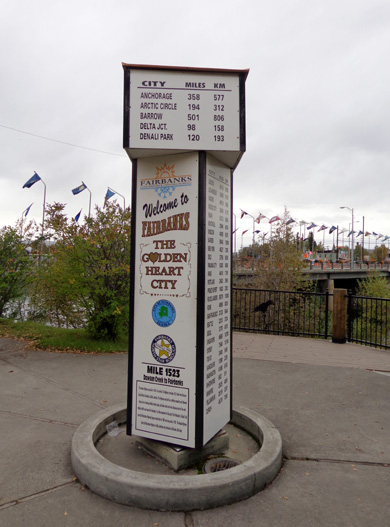
Denver = 3,152 miles, Los Angeles = 3,590 miles,
Washington, DC = 4,188 miles, New York City = 4,527
miles, Miami = 5,313 miles.
I'm guessing those are air miles, not road miles, since numerous cities
around the world are also listed by miles and kilometers. Road miles
would be even longer.
Aren't there easier ways to get to Alaska than driving all the way
there???
You betcha, but it's an incredible adventure just to reach Alaska if you
travel by road in an RV or passenger vehicle through Canada.
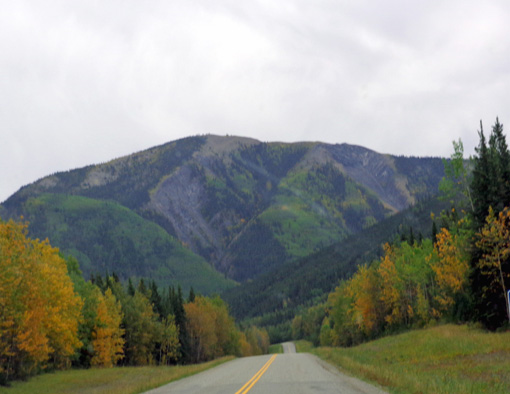
It's a roller coaster ride through northern British
Columbia and the Yukon . . . (9-7-12)
You have to think in terms of the "journey."
Even though we didn't spend time in all the towns on our way through
Canada we got a good feel for each area and know where we'd like to go
back someday. There are several different routes from which to choose
and lots of interesting places to visit along the way.
You miss that if you fly into the state. For many people, however, time
constraints and other reasons dictate that they fly to Alaska and rent a
vehicle there.
You don't even fully experience the journey if you take a tour bus
from the Lower 48; someone else is doing the driving
and making the decisions about where to go and when to stop. You may see
the same terrain from your window but you're less likely to meet the
locals and you can't do anything spontaneous, like spend an extra day at
a peaceful provincial park campsite next to a little lake where the fish
are teeming.
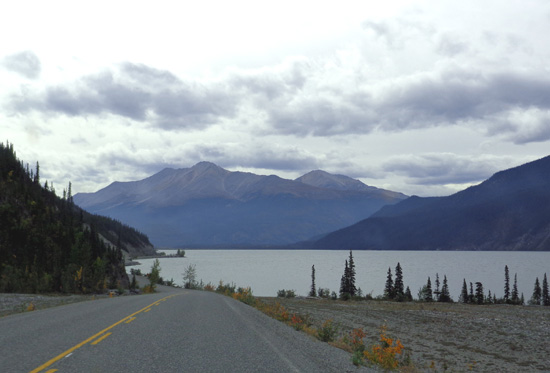
Beautiful Muncho Lake Provincial Park; this is one
of many
turquoise-blue glacial lakes in northern Canada.
(9-9-12)
A popular alternative to visiting Alaska is taking a cruise through the
Inner Passage in one or both directions. That allows visitors to see
interesting southeastern communities that can't be reached via the highway system.
Some of these tourists get off at the deep-water ports in Valdez, Seward, or
Anchorage and explore more of the state in a rental RV or passenger vehicle.
Another option is to put your RV on a ferry on the way to or from
Alaska. That way you can drive one of the routes through Canada and also
see the Inner Passage.
It's my understanding from the travelers' blogs I read that you cannot sleep
overnight in your RV on a ferry, however, and you can access it only minimally while on board.
That can present serious problems for folks like us who travel with one
or more pets. Another downside is the cost if you have a large RV;
rates are based on the length of the vehicle = how much valuable
space it takes up.
We're glad we did a road trip on our first visit to Alaska. That's
most likely how we'll get there on subsequent trips as long as we're able
to do the driving ourselves.
Next page: research and planning tips, including factors
to consider when timing your visit to Alaska
Happy trails,
Sue
"Runtrails & Company" - Sue Norwood, Jim O'Neil,
and Cody the ultra Lab
Previous
Next
© 2012 Sue Norwood and Jim O'Neil